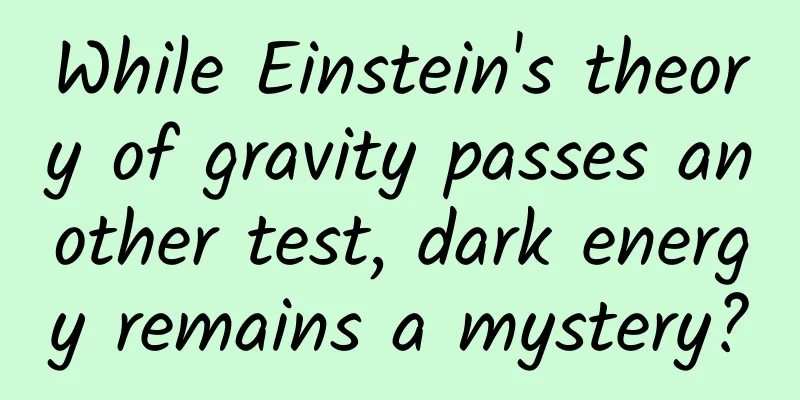While Einstein's theory of gravity passes another test, dark energy remains a mystery?

|
Dark matter vs. gravity: Einstein is always right New research could help scientists use gravitational lensing — the distortion of light from distant galaxies — to study the accelerating expansion of the universe. An artist's interpretation of Albert Einstein's theory of general relativity. (Image credit: Café Getty Images) Scientists are still searching in vain for flaws in Einstein's theory of general relativity to explain the mysterious force driving the universe's accelerated expansion. The researchers studied 100 million galaxies, looking for signs that the strength of gravity has changed over the history of the universe or over vast cosmic distances. Any sign of such a change would suggest that Einstein's theory of general relativity is incomplete or needs to be revised. Changes could also reveal what dark energy is, which is the name scientists give to anything that causes the universe's expansion to accelerate, among other things. What causes the accelerated expansion of the universe. Although no changes in gravity's strength were found, the work will help two upcoming space telescopes — NASA's Euclid mission and NASA's Nancy Grace Roman Space Telescope — look for variations in gravity's strength in space and time. "As measurements become more precise, there is still room to challenge Einstein's theory of gravity," team member Agnes Feder, a former postdoctoral researcher at NASA's Jet Propulsion Laboratory (JPL), said in a statement. To understand why dark energy and the accelerating expansion of the universe are so unsettling to scientists, imagine pushing a child on a swing and watching her slow down and almost come to a complete stop. Then the swing suddenly speeds up and continues to move rapidly without any push. The way scientists have been telling us is that after the initial push from the Big Bang, the expansion of the universe should have slowed down. But it isn't. It's speeding up, and the term "dark energy" is a placeholder for the mysterious force driving that acceleration. So dark energy is actually fighting gravity -- while gravity pulls cosmic objects together, dark energy pushes them apart. Since dark energy makes up about 68 percent of the total mass of energy and matter in the universe, it's a mystery researchers are eager to solve. So the Dark Energy Survey team used the Victor M. Blanco 4-meter telescope in Chile to look back five billion years. Testing gravity through space and time Light travels at a constant speed, which means that astronomers see distant cosmic objects as they appeared in the past. For example, it takes about seven minutes for light to travel from the sun to Earth, so the stars we see from Earth are as they were seven minutes ago. Even farther out, when astronomers observe objects in the Milky Way one light-year away, they see them as they were a year ago. For some of the distant galaxies being studied by the James Webb Telescope, the light has been traveling to us for tens of billions of years, and we are seeing galaxies as they were 13.8 billion years ago, when the universe was in its relative infancy. It's not observations of the galaxies themselves that hint at changes in gravity's strength, but rather what happened to their light on the long journey to the telescope. An exploration of time and space According to general relativity, mass curves the fabric of spacetime, with more massive objects producing more extreme curvature. A common analogy is placing balls of different weights on a stretched rubber mat. A bowling ball leaves a deeper dent in the mat than a tennis ball; a star warps spacetime more than a planet does. Objects like galaxies warp space-time so strongly that when light passes through a galaxy, its path is bent, and the apparent position of the object that emitted it in the sky changes by the time the light reaches Earth. Astronomers call this effect gravitational lensing. On July 11, 2022, NASA's James Webb Space Telescope released the first publicly available science-quality image, the deepest infrared image of the universe yet. (Image credit: NASA, NASA, Canadian Standards Association; and Space Telescope Science Institute) Because light from a luminous object takes multiple paths through massive objects such as galaxies — called lensing objects — gravitational lenses cause the light source to appear distorted, magnified, and even blurred in multiple locations on the sky, making distant galaxies appear blurred in the first image taken by the James Webb Space Telescope. However, the effects of gravitational lensing are much more subtle, and these subtle effects are usually caused by the presence of dark matter. Since dark matter only interacts with gravity, while neglecting light and other matter, its shape and structure are caused by gravity alone. Einstein was right again In recent research, scientists studying dark energy looked for these subtle distortions, called "weak gravitational lenses," in images of distant galaxies. The researchers reasoned that this would reveal changes in the distribution of dark matter in the lensing galaxies, which in turn would hint at changes in the strength of gravity over time and space — revealing the mysterious dark energy. Observations of the shape of dark matter in 100 million galaxies show that everything still fits with Einstein's general theory of relativity. That doesn't mean the search is over. Astronomers will now focus on the Euclid and Roman space telescopes, due to launch in 2023 and 2027, respectively, to look for variations in gravity in even older galaxies, hoping to find changes that could open the way to understanding dark energy. While the new study looked at galaxies as old as 5 billion years, Euclid will look back to 8 billion years ago, and Roman will go even further back, observing galaxies as old as 11 billion years, according to NASA. "We still have a lot to do before we're ready for Euclid and Rome," Feder said. "So we must continue to collaborate with scientists around the world to solve this problem, just as we are doing with the Dark Energy Survey." The team's findings were presented at the International Conference on Particle Physics and Cosmology (COSMO'22) in Rio de Janeiro on August 23. A paper detailing the team's findings has been published on the preprint repository arXiv.org. BY:Robert Lea FY:jane If there is any infringement of related content, please contact the author to delete it after the work is published. Please obtain authorization for reprinting, and pay attention to maintaining integrity and indicating the source |
>>: Is an egg a day good or bad? How many eggs a week is the healthiest?
Recommend
World Psoriasis Day | Don’t brag, this kind of “ringworm” cannot be ignored!
October 29 is World Psoriasis Day. Psoriasis, com...
What's happening with the ozone hole over Antarctica now?
Author: Wei Ke On May 16, 1985, the famous magazi...
The childhood snack "shredded figs" has nothing to do with figs?
I believe that for those born in the 1980s, the l...
Why are instant noodles curved instead of straight?
This article was reviewed by Liu Shaowei, food sa...
Uncle Wolf's Little Red Book Hot Product Promotion and Traffic Training Course No. 11
The 11th course catalogue of Wolf Uncle's Xia...
What happens when your bank card is full?
Source: Dr. Curious...
NDRC releases electric vehicle electricity price policy: not expensive
The National Development and Reform Commission iss...
Understand at a glance: The correct way to use express delivery and takeout during the epidemic!
Recently, with the spread of the epidemic and the...
Android Activity Security
Each Android Application is composed of basic And...
2020 China Internet Advertising Trend Report!
In previous sharing, we said that 2019 is the fir...
Good news for people with allergies. Will the new coronavirus avoid you?
[This issue's rumor]: Recently, there are rum...
Super Fan Pass is online, how to use it? This guide may be the most complete!
On August 23, all Fans Channels were switched to ...
Creative advertising materials for the Meiyu Women’s Platform!
As women’s education and employment levels improv...
Money is gone just by tapping your phone? You have used this feature before! Fraud prevention guide included →
In recent years With the popularity of smart phon...
Growth activity promotion matrix for online education!
Online education has developed rapidly in 2020 an...









